ARKANSAS STUDY TOUR
JULY 2023

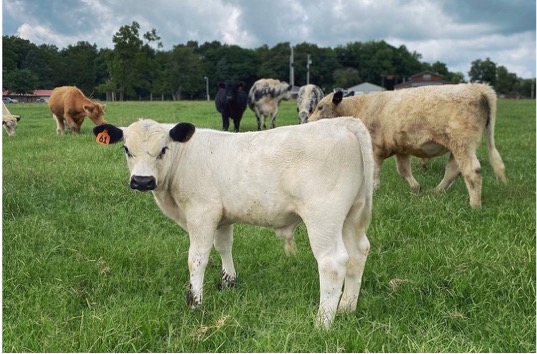


Karen Shepherd, Hazel Turner, Jennifer Mitchell, Jenny Leech, Myles Canning, Sophie Cameron, Pippa Shell, Holly Rodges, Sam Shearlaw,& Rhona Campbell-Crawford

INTRODUCTION
A group of ten students and two lecturers have spent the month of July in Arkansas, USA to learn about US agriculture and culture. This trip was partnered with the University of Arkansas, primarily the Bumper’s College for Agriculture, where Dr Jefferson D. Miller, in conjunction with SRUC lecturer Craig Davidson, organised and led the trip. We were learning about US agriculture through a variety of means – lectures, visits, tours, and presentations. It has been an eye-opening experience for everyone that was fortunate enough to go on the tour and we have learnt a great deal along the way.
WEEK ONE: Lectures
Our first week once arriving and settled in was focused on receiving lectures and talks from various faculty members of the Bumper’s college about different areas of agriculture within the US and to learn more about the University of Arkansas itself.

We spent the first few days getting acquainted with the campus and getting in-depth orientation of our plans for the next four weeks as well as a tour around the campus seeing everything from the football stadium to the sorority houses, where Dr Miller told us about the history of the University of Arkansas.
It was then the 4th of July, and we got to experience a true American Independence Day celebration at the local baseball park. Although it was the local minor baseball team that we came to see, it was the fireworks display that blew us all away after the game.
After the national holiday, it was time for us to start learning with our first day of lectures.
Our first lecture was on ‘USA and Arkansas Agriculture’ by Dr Miller. We discussed what the main agricultural outputs of Arkansas are: rice, poultry, cotton, soybean, wheat, and corn. It was also interesting to learn that ninety-five percent of Arkansas’ land resources are used for agriculture and forestry. We also looked at agriculture across the US and it was here that we already to start notice some very big differences compared to Scotland -especially, the fact the US farmer’s do not receive any subsidies, and that it is very common for farmers to be part-time farmers as they will have a day-job that is their main source of income.
Our next lecture was about ‘Agriculture Education in the US’ by Dr Estepp. In the USA agriculture is taught as a high school subject, which allows for the students to have more knowledge of where their food comes from, and the work that goes into agriculture.
It is also a subject that teaches them transferable skills that they can use no matter what path they choose to follow later in life.
Agriculture Education follows a 3-circle model:
- FFA (Future Farmers of America): this provides opportunities for its members to participate in competitions and conferences etc, that promote leadership, career success, and personal growth.
- Supervised Agricultural Experience – a project outside of the classroom, it can be exploratory, entrepreneurship, placement, or research.
- Classroom Instruction – organised teaching in the classroom, labs, or greenhouse.

Our final lecture that day was on ‘Advocacy for Agriculture within the US’ by Dr Miller. Advocacy groups are a massive part of US political culture and are also used by farmers to promote and defend their interests and industry. There are many different scales of advocacy groups from state groups to national.
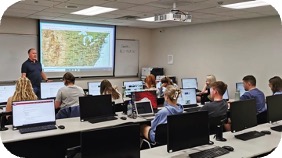
These groups are funded by checkoffs, so each farmer pays a fee upon the sale of their product as their membership and to help fund the advocacy group. These funds are used for industry marketing, promotion, research, and development.
There are advocacy groups for every part of the industry from the Arkansas Farm Bureau, United Soybean Board, Dairy Farmers of America, and the Arkansas Cattlemen’s Association.
The next day we met over Zoom with Cody Burkham, from the Cattlemen’s Association about the US Beef Industry. It was insightful to learn about the beef operations in the US, and that eighty one percent of cow operations in the US are less than one hundred cattle, which was interesting to learn as most people’s perceptions of US beef is feedlots, but they only contribute to a small number of operations across the states. The US in the last one hundred years has used genetics to significantly increase the amount of beef that they are able to produce while decrease the overall countries herd size.
Cody also was able to tell us about the influence that the Cattlemen’s Association has had on governance and some of the changes that they have been able to cause. For example, they were able to lobby to the federal government for farmers to receive subsides during droughts would be tax free, saving farmers tens of thousands of dollars a year. These groups have the impact to spark change for their benefit, which is something farmers in Scotland are missing.
The next day we met with Dr Lona Robertson, the Dean of Bumpers College. She told us all about the US college system, and how the University of Arkansas is a Land Grant University, which means it receives state benefits and has its roots in Agriculture. It was interesting to learn about the freedom and all the pathways that students in the US have with their education in addition to the many opportunities in front of them. It has influenced a lot of us that have been on this trip to return to Arkansas for a Masters or internship in the next few years.
Our next talk was from Shane White, a PhD student, on ‘Art as a Persuasive Tool to Promote Sustainable Practises’. Shane is promoting through his work and studies that visual imagery can be a powerful tool to influence conservation efforts by evoking emotions, raising awareness, and promoting behaviour change. He has worked on various projects throughout the years to share his visuals on social media and documentaries. He then showed us his latest work which was a documentary on the wild Choctaw horses. Watching this short film conveyed everything to us that Shane was preaching, beautiful visuals do have the power to evoke emotion and change.
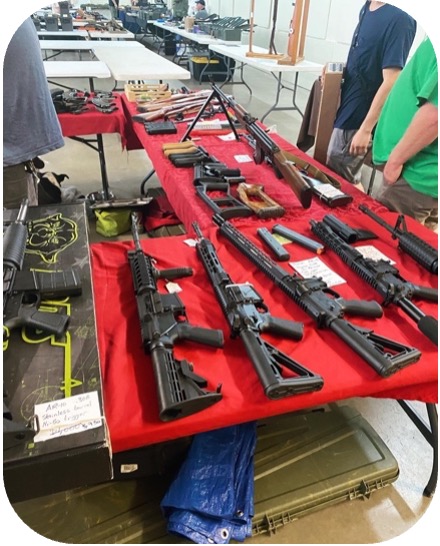
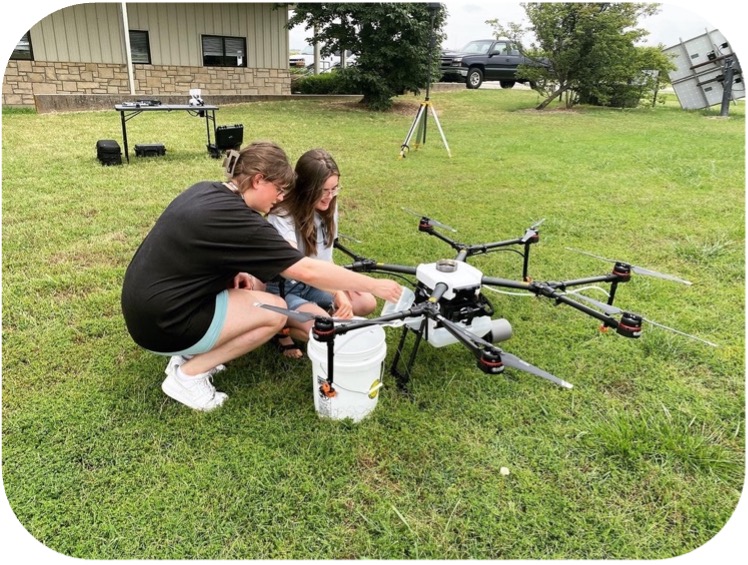
In the afternoon, we met with Shane White and Dr Koporan to learn about ‘Drone Technology in Agriculture’. Dr Koporan researches Ag Mechanics and showed us some of his latest prototypes which were made out of Lego and programmed to pick cotton. There also showed several functions that farmers and other ag businesses can use drones for: land imaging, surveying, irrigation, and spraying. We got a demonstration of an automated sprayed drone, and we were even allowed to fly some of the smaller drones ourselves.
On our first weekend in the states, the International Team at the University of Arkansas had organised for all of use to go to an American host family for dinner, so we can experience true American hospitality. This is a service that they run throughout the year for international students so that they can connect culturally with a family. Our group was split up between four families and we all thoroughly enjoyed the company and the food.
Since the purpose of this tour was also to learn about the culture of America, we went to a local gun show. America’s gun culture is very hard to comprehend for us, but a lot of the sellers were fascinating to talk to and very open to share their opinions about guns and their regulations.
WEEK 2 & 3: Tours
Week two and three’s focus was touring around the state of Arkansas for us to see first-hand American agriculture, and the different practises here. We mainly focused on farms and businesses in the Northwest Arkansas region but at the start of week three we ventured to see the eastern side of the state, as the geography and agriculture is very different there, due to it sitting on the flat delta Mississippi planes.
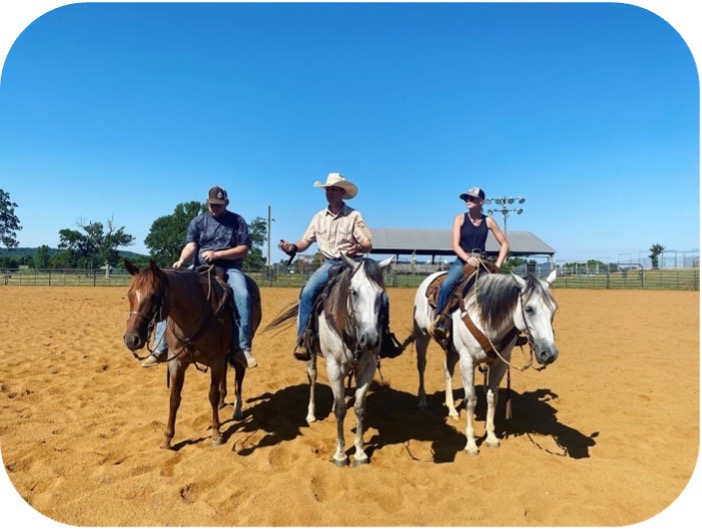
Our first visit was to the University of Arkansas’ Equine Centre. Where we were met by Jordan Shore, who is the coach of the Ranch Horse Team. This sport focuses on the horse’s ability to navigate obstacles, work and sorting cattle. Jordan then demonstrated some of the vital skills of the sport and even let us all have a go at roping the dummy calves.
We then had a quick tour of the state of the art livestock arena which hosts events from show jumping to sheep shows. This is where we met Dr. Coffey who researches forage crops. We had an interesting discussion with him about the tall fescue toxins that are causing issues across the states. This is because fescue contains an endophyte fungus that is harmful to livestock which can result in reduced fertility, weight loss as well as digestive problems.
Dr Coffey then took us to meet Maggie the Cannulated Cow. A cannula is a small hole in the side of the cow’s rumen to allow researchers to study the digestive process of ruminants. This provides easy access for them to collect samples. It has also been used for education purposes as lots of local school children have had the chance to feel inside Maggie through the cannula. Some of us while on our trip also got this chance.
There are some possible risks to having a cannula as it could cause infection, bleeding, or damage to surrounding organs, but overall cannulated cows live a normal life as part of the herd.
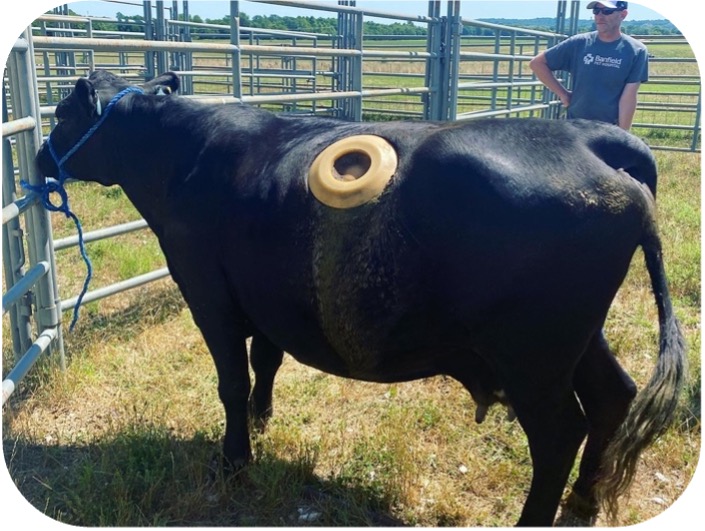
Our last trip of the day, Dr Miller decided to take us to see his own herd of cows. His operation represents most farmers in the US, part-time farmers with a small herd of cattle. He has a herd of around forty cattle which are predominantly angus, that he has on rented ground near the town. They were very friendly, and it was lovely to be given the opportunity to see his set up.
The next day, we went to Springdale and were given a tour of Tyson Foods Global Head Quarters by Zachary Young and Logan Estas. Tyson Foods is one of the largest food companies in the world, specialising in the production of chicken, beef, and pork. The company was founded in 1935 in Springdale with just five hundred chickens and now have over one hundred twenty thousand employees worldwide. Tyson Foods invests heavily in the research and development of its products, operations and sustainability practises.
Tyson have vertically integrated its poultry system, as they own all the birds on the poultry farms and the farmers are contracted to raise them. They also have control over all the poultry plants and make sure everyone in the chain is following welfare guidelines. This system means that farmer’s get a mean price across the market, giving them stability.
At the Tyson Headquarters, there are nineteen test kitchens, which chefs and food scientists use to help develop new products. They also work on recipes for clients in the fast food industry; McDonalds, Burger King, Taco bell, Wendy’s and Panda Express to name a few.
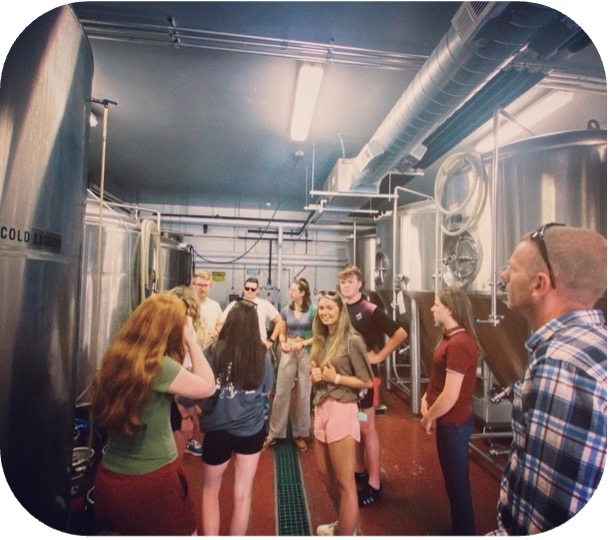
In the afternoon, we were off to Core Brewery, who are the official craft beer of the Razorbacks. The company was founded in 2010, and they are now the second largest craft brewery in Arkansas, as well as selling in twenty-six states across the country.
We got a tour of their brewery and canning facilities to learn more about their process, before getting to sample a few of their products ourselves. They have diversified their market recently as they now produce and sell hard seltzers called ‘Scarlet Letter’ which is now their biggest selling product, as well as the biggest selling drink in the Razorback football stadium.
The next day we headed to the North Arkansas Livestock Auction, where we were kindly given a tour by Myle. The market opened in 1959 and has one sale a week with roughly one thousand five hundred cattle going through a day. Eighty percent of buyers come from out of state to buy cattle here.
There are testing requirements for cattle before they are allowed in the market, mainly that bulls must be tested for sexually transmitted diseases such as Trichomoniasis or Bovine Venereal Disease. At the market we also learned about the American cattle tagging system. They must be tagged with a metal tag before they are one year old, all dairy cattle must have it, but it is not mandatory for beef. The tag has a beginning code which represents each state, so that they can track where the cattle have come from.
Everyone’s favourite part of this tour was seeing the cowboys at work in the barn, as they are used to pen up the cattle after they have been sold.
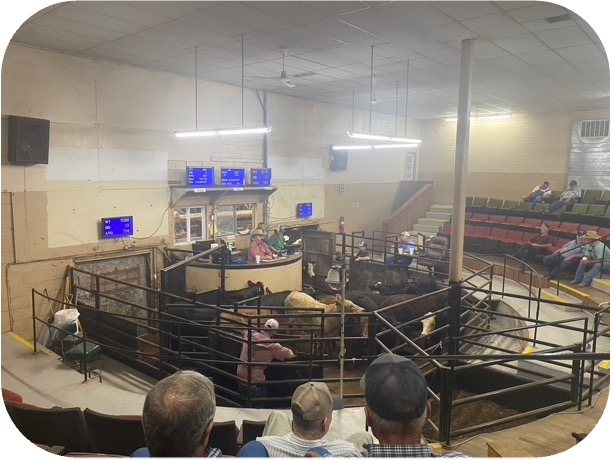
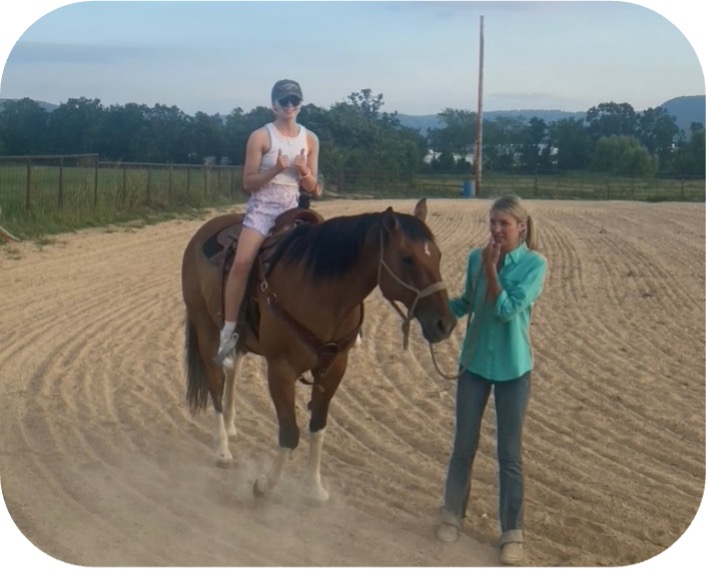
We then headed to Eureka Springs, for some shopping and food, which is a quaint little town filled with beautiful art and artisans. It is known for its preserved Victorian buildings in its historic district and has become one of the largest tourist destinations in North West Arkansas.
After dinner, we headed to a horse ranch that is owned by one of Dr Miller’s students, Kelsey Phillips. She runs her own business, KP Shining Performance Horses, training horses as well as competing in barrel racing.
She was kind enough to show us her beautiful colt, Bunny, as well as let us all have a go at riding western style on one of her horses. Finally, Kelsey showed off her talents, with a seventeen second barrel race, and we were all in awe.
The next day we continued our tours in nearby Bentonville to visit the Global Headquarters of Walmart. Walmart is a multi-national chain of hypermarkets that was founded in Bentonville, Arkansas, which has grown and grown and is now the largest employer in the world. Bradley gave us a fantastic tour of the company, showing us everything that they have to offer from radio, tv, pilots and emergency disaster relief operations, everyone at Walmart really seems to live the company’s motto, that people make the difference.
We then met with the Meat Department at Walmart. Grant, Walmart’s resident cowboy, told us about their Gate to Plate Initiative, where Walmart are now buying and rearing their own cattle to ensure a premium product for their customers. As all their producers must be beef care certified and is classed USDA upper choice.
We then headed into Bentonville town square and went to the Walmart Museum. It was great to learn more about the history of the company and even chat to the hologram of Sam Walton himself.

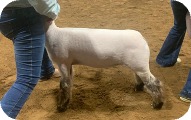
On Saturday, we headed to a local sheep show, held in the U of A livestock arena. Even though sheep farms are not common commercially in America, it is very common hobby for kids to show sheep. We were shocked to see the stark difference between how the sheep are dressed here compared to home. They are completely bare to show off their muscle and carcass, apart from their legs which the wool is kept long to make them look bigger boned.
For dinner, we went to a local steak house, Doe’s, with Dr Miller and his wife. Doe’s had come highly recommended as we were told that we have to try American grain fed steak, and it did not disappoint.
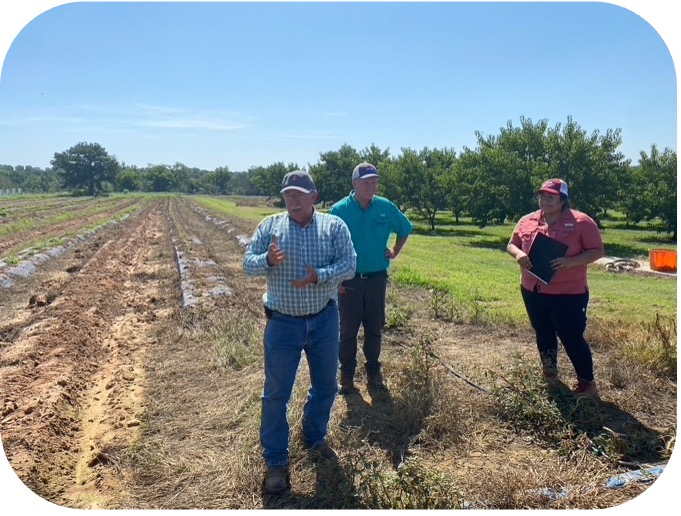
The start of the second week of tours we headed to the east side of the state, leaving the Ozark mountains behind, and moving to the flat Delta Planes of the Mississippi River. Our first stop was to the Arnold Family Farm. They grow five acres of strawberries and have seventy cows which he breeds and finished. Ten years ago they opened their farm shop where they sell their fruit and butchered beef.
Arnold was kind enough to show us around his farm himself and teach us about his plastic raised bedding and irrigation systems that he uses for his delicious strawberries. Their business has grown significantly in the past three years, that they now need to buy in local produce to supply their farm shop year round.
We continued to head east and visited the U of A Fruit Research Station, where Jackie, director of the station, showed us around. The station is dedicated to breeding new fruit varieties and improving the management practises for development.
Currently, their fruit breeding programme includes blackberries, blueberries, peaches, table and muscadine grapes. They have been breeding at this station since the 1950’s and have released sixty-six varieties and have various patents for the varieties that they have created.
They are renowned for their blackberry breading programme and their blackberries are now on every continent on the planet. We were lucky enough to sample a few, and we were amazed at their size and the fact that they have managed to breed out thorns on some of their varieties.
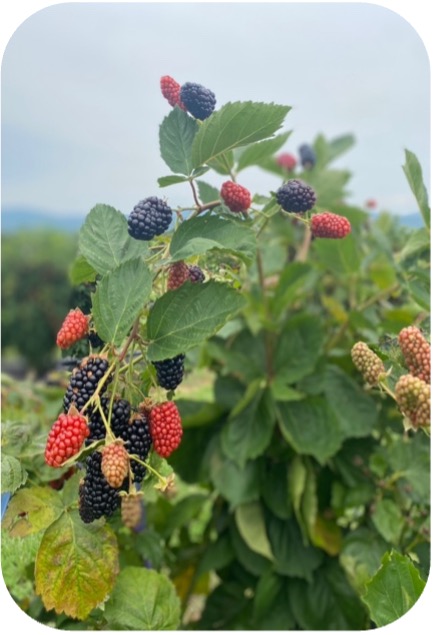
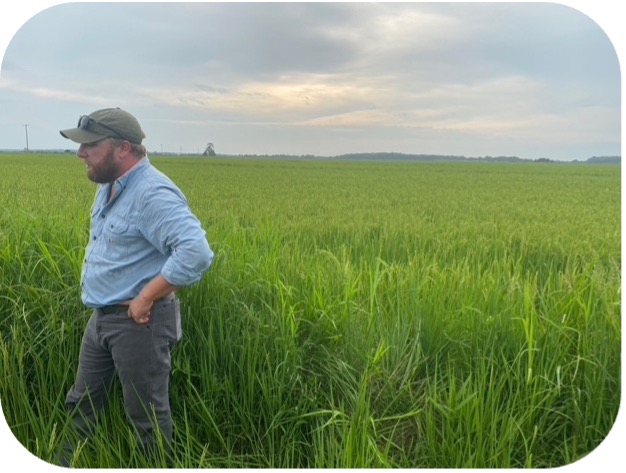
We then headed along to Carlisle, where we visited the Parker Rice and Soya bean farm. Clay toured us around his impressive 9,000-acre farm. For all of us this was the first time we had ever seen rice grown in fields. To grow rice efficiently in this area most of the farmers level their fields to a zero gradient so that they can maintain a three-inch flood depth evenly throughout the fields.
Rice is the cash crop for farmers like Clay, despite the fact it requires far more man hours compared to other crops and it brings in most of their profit. Clay ha also diversified his business as during the duck hunting season he will keep fields flooded to create habits for waterfowl. He will then guide tours of hunters through his farm. This is very popular in this area of the state for farmers to do as it is known as the duck hunting capital of the world.
That night we stayed the night at a beautiful duck hunting lodge, that an alumnus had kindly donated for us to stay in, and the next day we set off early on our travels to Stuttgart to visit the Dabbs Farm, which is a discovery farm.
A discovery farm works with the local extension agents to conduct research and practise new techniques. If successful they will then share the knowledge with other farms in the area. This rice and soya farm is focused on water conservation.
They have added reservoirs and ditches to catch all the water that has been irrigated on the crops, this water then is reused for irrigation, creating a closed cycle of water usage on the farm. Therefore, they are now able to fully irrigate their crops from the water they catch, thus not needing to use groundwater from wells.
This is incredibly important research for this state as in the past few years they have suffered large scale droughts and with this new infrastructure, means that the farm is now practically drought proof.
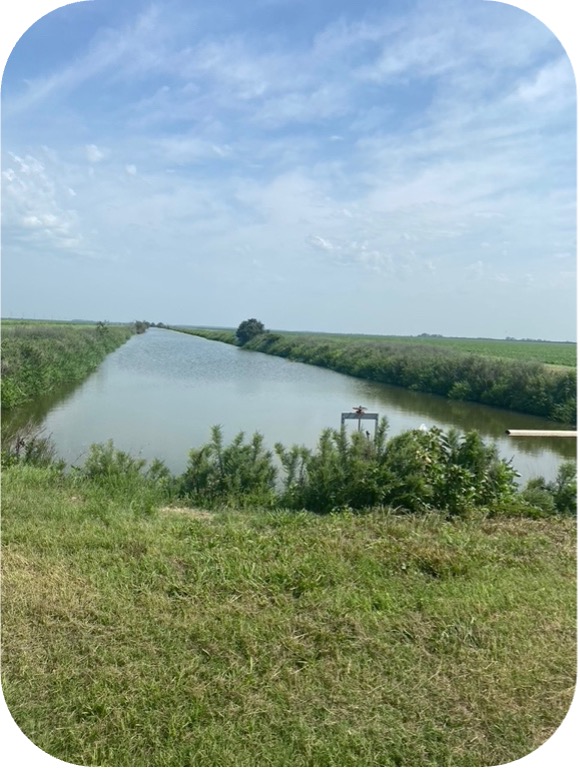
In the afternoon, we headed to Riceland Foods Global Headquarters. Riceland is a farmer-owned co-operative that over five thousand rice farmers are a part of. It is the largest rice miller and marketer in the world and produces everything from Kellogg’s to Budweiser.
It owns and operates six mills, and its principal business is receiving, storing, milling, packaging, and marketing rice, grain, and by-products. Riceland markets its products wholesale and retail channels, food service, ingredients, co-products, and other local and global companies. Arkansas is the largest rice producing state, and because of the global outreach of Riceland, everyone across the globe will most likely have had Riceland rice.
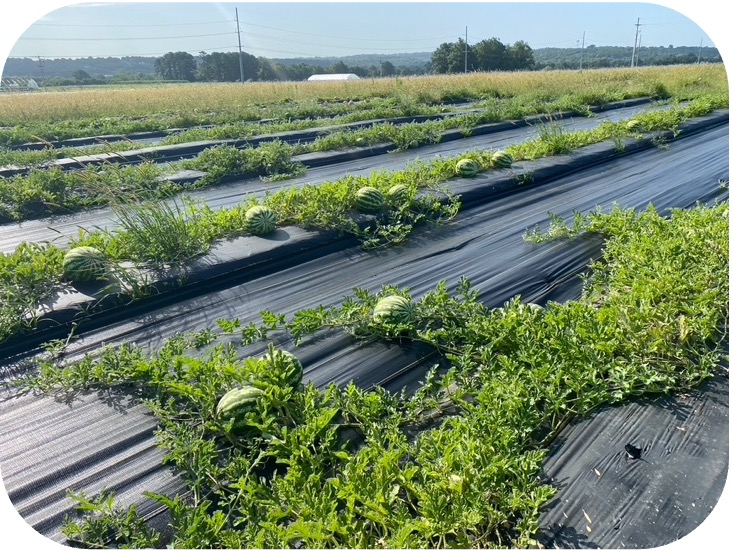
The next morning, we headed to the U of A CAFF Fruit and Vegetable Farm. At the farm, they run a one-year program for students to learn about agriculture, how to grow their own fruits and vegetables and how to make it a profitable business.
They let the students grow any produce they want on their group patches; melons, peppers, tomatoes, sunflowers, squashes and berries. They have only run for three years but its growing and growing, just like their wonderful produce.
In the afternoon, we headed to Crystal Bridges Art Museum in Bentonville. It came highly recommended and it did not disappoint with their beautiful collection of classic and contemporary art.
On the 20th of the tour we visited Willow Springs Cattle Company in Prairie Creek. The herdsman Cody was an excellent host and gave us an insight on showing sheep and cattle in the states.
Starting with the sheep, they have a very different ‘look’ compared to back home, to get them ready for the shows their leg hair is kept long and is washed every other day, then wrapped for protection. They are also put on a treadmill twice a week, to help build muscle.
Their angus cattle are what they are known for, and they have managed to create a reputation for excellent heifers and bulls that kids buy then show across the county, achieving some of the biggest awards. Cody was great in telling us about their use of AI, IVF, and embryo flushing. His preference is to embryo flush his cow then only use the heifer embryos. For showing their cattle, they want them fluffy, with as much hair as possible.
To achieve, this they trick the cows into thinking its winter by keeping them cool in a fridge room, so that they grow more hair. They also are washed every other day to achieve the perfect look. The washing removed old or dead hair and stimulates a healthier coat. It is a lot of work that they put into their cattle, but it pays off.
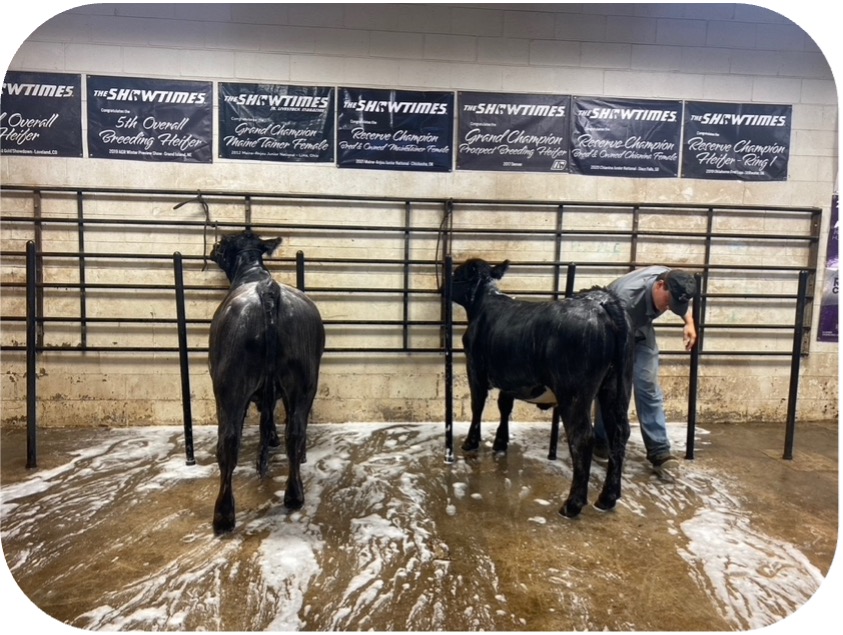
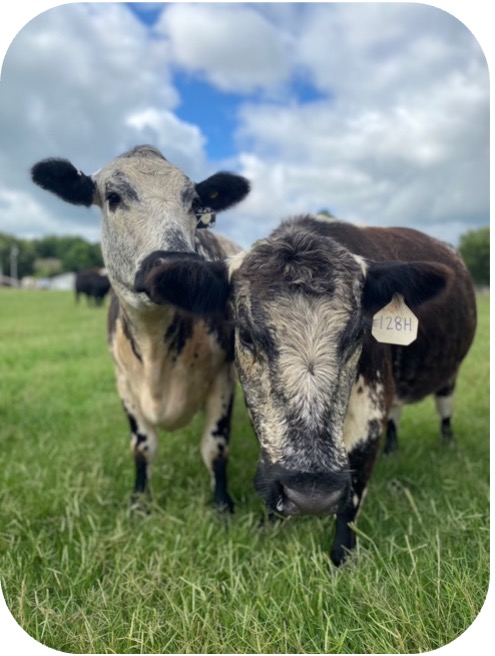
The next day we headed to Blue Ridge Farm, where we met the Hewitt family’s Specklepark Herd.
This is a relatively new breed to the states that hails from Canada and creates these beautiful cows. They have a small seed stock herd, with around forty cows and five bulls.
With some of their best cows they are using embryo flushing to improve the qualities of their herd and have been selling their bull’s semen on the private market. Also, they have been taking them to shows and sales across the US and Canada, to help promote and establish the breed across the states.
We headed to the Professional Bull Riding in Springdale. Everyone loved it and found it to be a great night’s entertainment, and luckily none of the bull riders got too hurt.
At the weekend we crossed state lines into Oklahoma, to spend the day at the Cheek family’s lake house of the Grand Lake, they were fantastic hosts who gave us beautiful food and let us experience a true American lake day.
We got the chance to swim, dive, kayak, go on a boat ride, and drive jet ski. However, we did all end up with a lot of sunburn.
On Sunday, Dr Miller and his family invited us over for dinner. Marcie made us the most delicious meal and we spent the evening playing cards and cornhole.
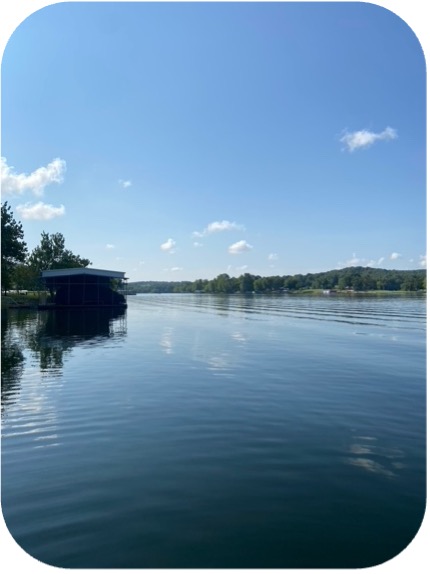
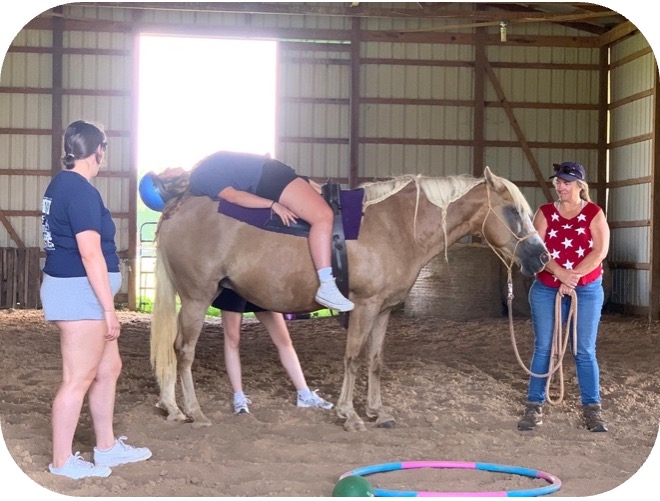
Our final visit of the tour was to Courage Therapeutic Riding Centre, where we met with Karen and Jessie along with their herd of ten therapeutic horses.
Jessie told us all about the work they do with various groups in society: physical therapy for people with mental and physical disabilities, foster children, cancer survivors, veterans, and felons. Helping all walks of life feel better by connecting with the horses and nature.
Some of us got to experience therapeutic riding for ourselves, where they get the individual to ride bareback for them to fully feel the rhythm and warmth from the horses to help them relax and connect.
Finally, we got to see the effect these horses can have on people first hand as we joined in on a session with Sammy. It was lovely to see the joy in her face that Dolly that horse gave her.
Before we arrived in America, we were all paired up with an American student to become pen pals with and we had all sent each other letters. Therefore, throughout our stay we all have been meeting up with our pen pals. People have attended horse shows, went to Topgolf, hiking, out for dinner, shopping, and the cinema with their respective pen pals throughout our month in Arkansas. It has been a great way for us to connect with Americans on a deeper level and some of us have certainly made friends for life.
WEEK 4: 4-H Presentations
The final week of our tour was focused on preparing presentations and a stand for the 4-H conference that was happening on campus at the end of the week.
4-H is an agricultural youth organization whose mission is ‘engaging youth to reach their fullest potential while advancing the field of youth development’. Students attend conferences each year to partake in competitions, attend workshops and events to gain life skills in leadership, responsibility, and citizenship.
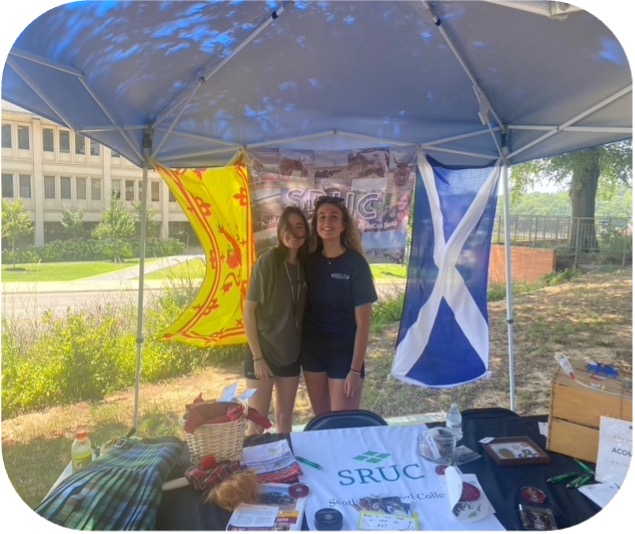
Dr Miller had organised for us to teach groups of 4-H students about Scottish agriculture, through hosting a stand during the careers fair and hosting presentations.
We made posters and brought items from Scotland to show the students such as a kilt for them to try on, various agricultural equipment, as well as tablet and shortbread for them to try. Everyone took turns on the stand, and everyone seemed eager to learn about what Scottish agriculture has to offer.
We then spent the rest of the week creating presentations for our hour-long workshops, where we wanted to go through the main elements of Scottish Agriculture as well as providing comparisons to agriculture here.
One of the comparisons that the students enjoyed the most was comparing the size of their angus cattle to ours. We presented to two different groups on the Thursday, and it went very well and the students were very engaged and interested, so much so that one boy even came dressed in a kilt.
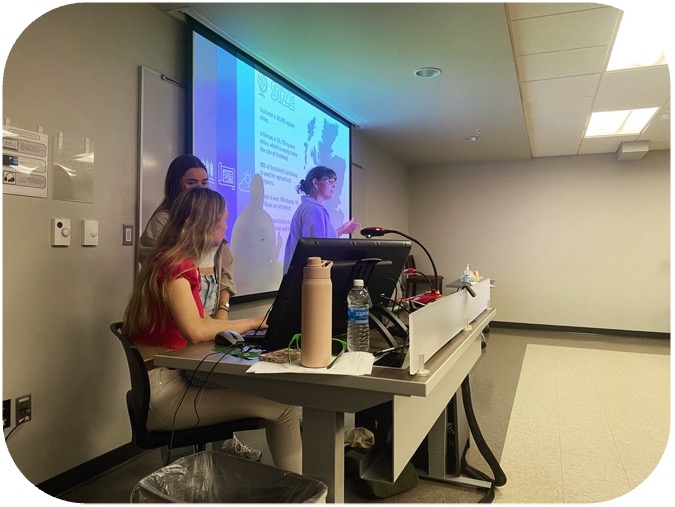
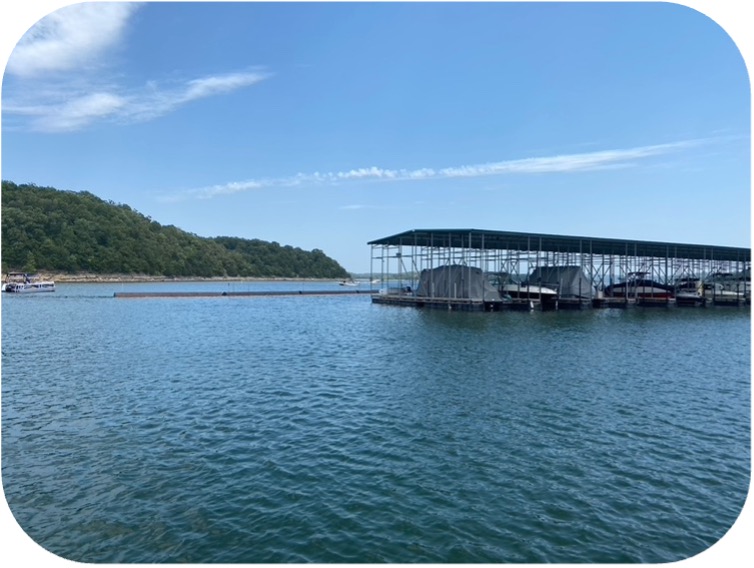
Our last full day, before flying home we headed up to Rogers for some shopping and brunch.
Then we headed along to see the stunning Beaver Lake, as it one of the must see attractions of the Northwest Arkansas region and we didn’t want to leave without seeing it and having a swim.
It was a lovely day to end our month-long tour with.
CONCLUSION
This trip has been an incredible opportunity for everyone that was fortunate enough to partake in it. It has provided us with a first-hand insight on how agriculture works in the US and has amazed many of us to how different it is compared to Scotland. It has helped people grow their confidence in traveling and experiencing different cultures as before this trip, some of us had never even left Scotland. It has also helped us broaden our horizons about what we can do with our future, and perhaps opening doors that we never thought were possible. I know that all of us would come back to Arkansas in a heartbeat, whether it is to do an internship, Masters or just a holiday.
We would like to specially thank our stakeholders for the opportunity to participate in this once-in-a-lifetime experience. Without the support of our partners this would not have been possible. Funding for this exercise was provided through Scotland’s Rural College, the John Cameron Trust, the Roy Watherston Memorial Trust, and individual student contributions. The funders of the trip graciously contributed to the following associated costs: Accommodations, meals, flights, transportation, insurance, travel visas, cultural activities, and sundry expenses. Thanks again for their generous support of our career success and personal growth and for the lifetime of memories made.
